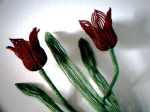Following
this profound experience, Linda was offered a job in Ottawa, and she began
another stage in her career in what she refers to as the Aboriginal public
service. First with the National Association of Friendship Centres,
then the Native Council of Canada and the Native Women’s Association of
Canada, Linda became well known and respected in the Aboriginal
community. But despite her accomplishments and achievements, Linda
was still experiencing significant personal struggles -- one of which was
well-hidden -- and which altered her thinking and behaviour. Seeking help
in 1992, Linda realized what the problem was -- alcohol. Entering a
life of sobriety kept her on a mostly even keel while she was with the
Royal Commission on Aboriginal Peoples. Here again, Linda’s
knowledge and skills were utilized, and with the exception of the very
legal text on the Indian Act, Linda wrote the Women’s Chapter for the
Final Report of the Commission. But her path was not easy - because
she cared so much, she became a workaholic and didn’t take care of
herself - emotionally, physically nor spiritually. After three and a
half years of sobriety, she traveled on what she calls ‘that other road’
for another year and a half. Today, Linda lives a life of sobriety -
one day at a time - and understands that change must come from
within. The path to recovery and self-discovery is never-ending -
you always have to work on it - but with passion, willingness, acceptance,
honesty, a positive attitude and an open mind. Linda continues to be
involved in making contributions towards improving the quality of life for
Aboriginal people and now works for the Department of Indian Affairs and
Northern Development. She is an advocator for political and social
change and has successfully made major inroads in the area of social and
health related programs and services. She has received numerous
awards and recognition for her work, and has been an integral inspiration
and mentor in my own personal and professional development. Linda is
more like a sister to me than a cousin. We remain very close, and she
continues to inspire and encourage me. She is a kind, thoughtful,
independent woman, who has given much of herself throughout her
lifetime. Linda has shown me the true meaning of honesty; honesty in
accepting myself for who I am, and that honesty is to face a difficult
situation with bravery. I love her very much, and she will always be an
inspiration to me.
|
